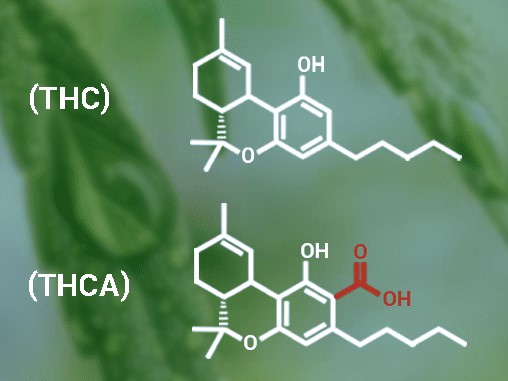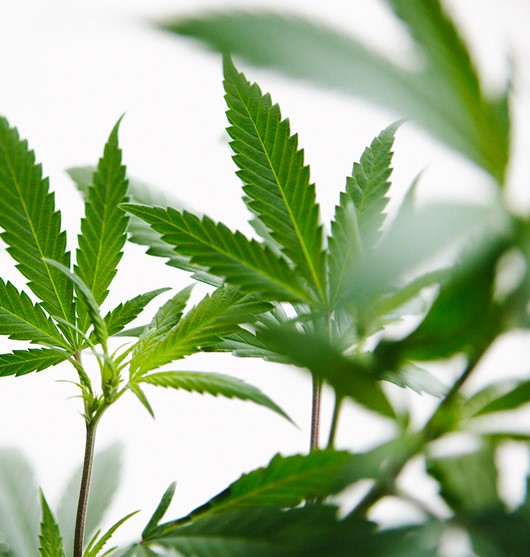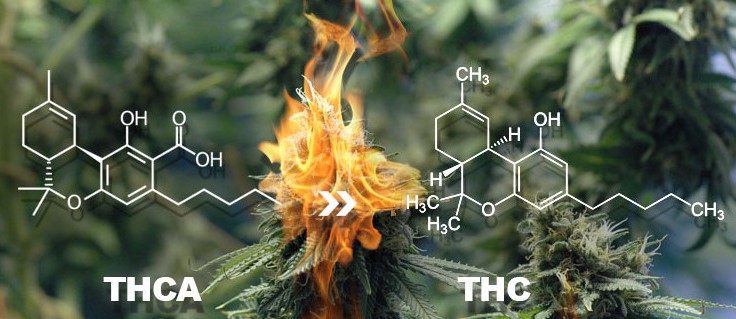When cannabis leaves mature, they produce a distinct set of cannabinoids. Because THC contributes to the psychotropic effects we experience after smoking marijuana, it is the most well-known cannabinoid. However, did you know that cannabis does not create THC directly? Instead, it transforms tetrahydrocannabinolic acid (THCA) and cannabidiolic acid (CBDA) into cannabigerolic acid (CBGA), which is utilized to synthesize all cannabinoids in an acidic form. You can buy Cannabis with our weed affiliate programs canada.

THC has an anti-inflammatory effect, which is why it’s called a “cannabimimetic.” THCa does not produce a high. The cannabinoid must undergo decarboxylation in order to convert THCa to THC. When fresh buds are dried and cured, this process begins. However, when THCa is subjected to heat, for example through smoking, vaporizing, or cooking food with it in its acidic non-psychoactive form, the majority of it transforms into THC in its basic non-psychoactive form. In other words, THCa is THC in its elementary form
What is THCA?
Cannabigerolic acid (CBGA), the “mother of all cannabinoids,” accounts for the presence of all of cannabis’ most important cannabinoids. Enzymes present in each cannabis strain that convert CBGA to a variety of cannabinoid precursor chemicals as the plant matures include cannabidiolic acid (CBDA), cannabichromenic acid (CBCA), and tetrahydrocannabinolic acid (THCA).

Cannabichromene (CBC) is a CB1 and CB2 receptor antagonist that acts as a modulator in the endocannabinoid system. It’s known by its street name, “CBD,” too. THC stands for delta-9 tetrahydrocannabinol, which is the psychotropic cannabinoid present in cannabis plants. THCA is the chemical precursor to THC, which comes from thermal decarboxylation of cannabichromene (CBC). This explains why you won’t feel anything if you chew fresh cannabis; there hasn’t been enough time for sunshine or other sources of energy to elicit THC formation this way.
When cannabis is smoked, vaped, baked into an edible, or extracted to produce a concentrate, it generates intoxicating effects since the most common methods of consuming cannabis – smoking, vaporizing, cooking into an edible, and making a concentrate – are all strong enough to cause this change.
The Difference Between THC and THCa
The chemical structure and manner in which THC and THCa interact with the body are quite distinct. During the drying process, THCa converts to THC; a process that is sped up when heat is added to the equation, such as when smoking or vaping cannabis over time in order to be consumed. Decarboxylation, or heating and lightening of cannabis, causes a chemical change called decarboxylation, which removes a carboxyl group from the THCa molecule and makes it more receptive to interaction with the body.
The endocannabinoid system, which regulates pain and other bodily functions, is inhibited by THC because it only binds to CB1 and CB2 cannabinoid receptors in the body’s endocannabinoid system. Because THC is one of the cannabinoids that readily binds to CB1 receptors, it produces a euphoric sensation. That isn’t to imply that THC or raw cannabis don’t have any benefits. There are several, and more are being discovered and researched on a daily basis.
THCA vs THC
Although the two cannabinoids, THC and THCA, have many similarities and significant differences, they are similar in certain ways while dramatically different in others. To discover where they’re alike and where they differ, look at the lists below.
Properties of THCA:
- Non-psychoactive
- Naturally occurs in raw cannabis
- Weak activator of CB1 and CB2 receptors
- Represents up to 90% of the total THC content of cannabis plants
- May provide soothing and neurological effects
Properties of THC:
- Exerts psychoactive effects
- Produced through decarboxylation
- Stronger activator of the CB1 receptor
- Synergises with numerous cannabis terpenes including pinene, limonene, caryophyllene, and linalool
- Associated with several benefits including relaxation, sleep and appetite promotion, and euphoria
What Does the Research Say About THCA?
Although there is a lot of research on THCA, the bulk of it has been conducted on animals or cells. Until clinical studies are conducted, we must remain cautious about the effects of THCA on humans. However, the existing study provides us with an indication of what to anticipate.
· Weight Loss
Cannabidiol (CBD) is a chemical component of cannabis that has been discovered in previous research to aid in weight reduction. A study published in 2020 found that the cannabinoid activates PPARy receptors and aids in fat loss.
· May Soothe Joints
Through its impact on PPARy and the CB1 receptor of the endocannabinoid system, THCV may aid in the treatment of joint and other body parts.
· Queasiness
THCA may assist to relieve a nausea stomach, according to some early investigations. Although the evidence is still developing, this finding has the potential to enhance THCA’s relevance in cannabis research.
· Organ Health
In this study, researchers discovered that naringin-rich grape extract improved alcohol consumption in rats. Researchers also identified the presence of THCA in human liver tissue. This was one of several studies to examine the impact of THCA on liver health in mice. The results demonstrated promise, laying the groundwork for considerably more research in the future.
Benefits of THCa vs. THC
Cannabis is a fantastic superfood since it is high in vitamins, minerals, and antioxidants. Raw cannabis also contains a lot of fiber and omega-3 fatty acids, as well as vitamins C and K, calcium, iron, and folate. Furthermore, THCa and THC research has already produced some fascinating findings. THCa can assist the body in fighting nausea and hunger loss, inflammation and pain. THCa may be an excellent option for you if you’re looking for natural remedies to help with whatever your body requires – whether it’s after a long and tiring day or during recovery. Here are some additional advantages of THCa:
- DHA (docosahexaenoic acid) is a polyunsaturated omega-3 fatty acid that has been studied for potential neuroprotective effects.
- Epilepsy is a neurological disorder characterized by recurrent seizures. Cannabidiol (CBD) and other cannabinoids have shown promise as anticonvulsants in some studies, but further study is necessary for their use in different types of epilepsy.
- THCa has the potential to assist with inflammation reduction due to inflammatory bowel diseases.
- THCa decreased weight gain and pro-inflammatory cytokines in diet-induced obese mice.
THCa’s ability to work at lower doses than THC makes it a more desirable cannabinoid. With cannabis plant legalization coupled with the non-psychoactive nature of the chemical, THCa becomes even more appealing because it is now readily accessible to anyone who wishes to use it. You can receive THCa’s advantages from raw cannabis as well as some important nutrients.
How to Consume THCa
If you don’t want the mind-altering effects of THC but still desire THCa’s anti-inflammatory and antioxidant properties, there are a number of options available to you. There are simply so many ways to consume THCa since it is so bioavailable in raw cannabis. Start with adding THCa to salads, juices, salad dressings, or sauces as a great way to get started since it tastes just like any other leafy green vegetable. To find your sweet spot with any sort of cannabis, start small and work your way up slowly.
Understanding THC and THCA Potency Testing
To comprehend how your marijuana is labeled, it’s important to go over the two most prevalent testing techniques.
Gas chromatography (GC) occurs at high temperatures that convert extracted cannabinoids to a gaseous mixture, which is then run through a sort of filter that measures the different cannabinoid levels.
One issue with GC is that the heating technique causes some, but not all, of the THCA (and CBDA) to decarboxylate. Decarboxylation is the transformation of naturally occurring cannabinoid acids (THCA and CBDA) into THC and CBD by releasing carbon dioxide. Unfortunately, this makes GC unsuitable for testing edibles. It also raises the concern that test results might be underestimating a plant’s actual strength.
A new technique for isolating CBD from cannabis plants, however without the loss that occurs during decarboxylation, is nuclear magnetic resonance (NMR) spectroscopy. At room temperature, chromatography (LC), on the other hand, allows laboratories to test THC and THCA levels (as well as CBD and CBDA) without the loss that occurs during decarboxylation.
A more in-depth analysis can be useful for medical marijuana patients, but it comes with its own set of problems that makes it less appealing to recreational dispensaries. To start, LC systems and solvents are more expensive than their GC counterparts, and the higher testing costs aren’t an option for some businesses. Furthermore, just as crucial, test results from LC systems might be confusing, raising the potential for a label to be misunderstood and a marijuana consumer to take more than intended.
If a strain is advertised to have 22% THCA and 3% THC, how much active THC will you receive with each hit? How can you interpret THCA vs THC? Clearly, 3% isn’t correct – that’s far too little. Perhaps 22 percent makes sense because THCA is what transforms into psychoactive THC when burned. Alternatively, perhaps you’re supposed to combine the two numbers — THCA and THC — to get a 25 percent strain. However, given that THCA isn’t converted completely to THC , there are still more mathematical hurdles before we figure out the strain’s power.
The following THC formula may be used to calculate total THC when you know the percentages for both THC and THCA, according on a recent study of lab testing techniques.
THCtotal = (%THCA) x 0.877 + (%THC)
So in our example:
THCtotal = 22% x 0.877 + 3%
THC levels of 22.3% have been reported, meaning the entire batch is estimated to include roughly 22.3 percent THC. There we have it! However, one might argue that the modest accuracy boost isn’t worth the extra effort and expense unless you’re a medical marijuana patient.
What’s the best way to take THCA?
So depending on your needs, you can either heat THCA or administer without the heat.
Smoking THCA:
When THCA is heated, it converts into a highly potent version of THC. So, if you’re searching for something that will convert to that, you’ll be asking, “How am I supposed to smoke it?” You may dab it or add it to a bowl or joint of your preferred flower to increase the potency. No special equipment or engineering required.
“Woah” was the most common response when we compared smoking THCA. It’s clean, and when asked to describe it, we got a landslide of responses like “Like cannabis.” We’d advise you to exercise caution until you’re comfortable with your tolerance since the strength is considerable.
Non-Heat Methods of Administering THCA:
There are plenty of edibles on the market that offer THCA in its raw form, including: If you don’t want to experience a psychotropic high and want to utilize THCA for anti-inflammatory purposes, there are several edible goods available that are designed specifically for administering THCA in its raw form.
- Juicing: Yes, the leaves of your raw, fresh cannabis plant can be juiced and blended together to make a smoothie. This method extracts the most THCA from the leaves. If you don’t have access to constant quantities of fresh cannabis fan leaves, make a large batch and freeze the juice for later use.
- Tinctures or drops: THCA levels in cannabis tinctures are extremely high. These tinctures are simple to dose and transport, as opposed to juicing.
- Transdermal patches: The best time to apply the THC patches is in the evening, after your body has had a chance to process them. They work similarly to nicotine patches; simply adhere them for 8-12 hours on any veinous (noticeable or prominent veins) area of skin, which is usually the inside of the wrist or top of the foot.
- Pre-made edibles: There are a variety of THCA edibles on the market. We recommend doing your homework, buying from a known manufacturer, and requiring that each item be accompanied by test results.
THCA and potency
Even though THCA is a precursor to THC, it is still an important cannabinoid to consider when determining the potency of a cannabis strain, even though it is non-intoxicating.
Gas chromatography is one of the most frequently utilized approaches to quantify cannabis potency. There should be enough heat applied to the cannabis material being tested in order for it to decarboxylate the THCA present and produce THC, according on this method. In theory, this technique should be able to determine a product’s potency straight away because it is usually measured in terms of percentage THC.
However, as a result of the heating and decarboxylation, the cannabis substance will shed a significant amount of weight since the THCA molecules lose their carbonyl groups in large amounts. This must be considered when determining the total THC content of a raw cannabis strain. This calculation usually resembles:
THC total = (% THCA) x [final mass/initial mass] + (% THC)
In order to calculate the total THC content in a raw cannabis strain, you must first isolate and purify all of the other cannabinoids from it. This procedure yields an excellent approximation of the overall THC present in the plant. This is also known as the maximum THC because, under typical smoking conditions, not all THCA will be transformed into THC. It’s difficult to estimate how much THC was actually consumed, but studies show that 30-70 percent of THCA in a strain may not be converted during smoking.
